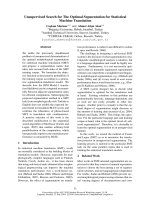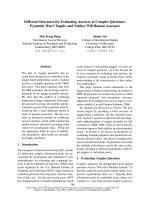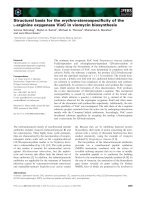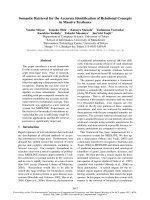báo cáo khoa học: " Female heterozygotes for the hypomorphic R40H mutation can have ornithine transcarbamylase deficiency and present in early adolescence: a case report and review of the literature" docx
Bạn đang xem bản rút gọn của tài liệu. Xem và tải ngay bản đầy đủ của tài liệu tại đây (274.53 KB, 4 trang )
CAS E REP O R T Open Access
Female heterozygotes for the hypomorphic R40H
mutation can have ornithine transcarbamylase
deficiency and present in early adolescence:
a case report and review of the literature
Jason R Pinner
1*
, Mary-Louise Freckmann
2
, Edwin P Kirk
2
, Makoto Yoshino
3
Abstract
Introduction: Ornithine transcarbamylase deficiency is the most common hereditary urea cycle defect. It is
inherited in an X-linked manner and classically presents in neonates with encephalopathy and hyperammonemia
in males. Females and males with hypomorphic mutations present later, sometimes in adulthood, with episodes
that are frequently fatal.
Case presentation: A 13-year-old Caucasian girl presented with progressive encephalopathy, hyperammonemic
coma and lactic acidosis. She had a history of intermittent regular episodes of nausea and vomiting from seven
years of age, previously diagnosed as abdominal migraines. At presentation she was hyperammonemic (ammonia
477 μmol/L) with no other biochemical indicators of hepatic dysfunction or damage and had grossly elevated
urinary orotate (orotate/creatinine ratio 1.866 μmol/mmol creatinine, reference range <500 μmol/mmol creatinine)
highly suggestive of orn ithine transcarbamylase deficiency. She was treated with intravenous sodium benzoate and
arginine and made a rapid full recovery. She was discharged on a protein-restricted diet. She has not required
ongoing treatment with arginine, and bas eline ammonia and serum amino acid concentrations are within normal
ranges. She has had one further episode of hyperammonemia associated with intercurrent infection after one year
of follow up. An R40H (c.119G>A) mutation was identified in the ornithine transcarbamylase gene (OTC) in our
patient confirming the first symptomatic fe male shown heterozygous for the R40H mutation. A review of the
literature and correspondence with authors of patients with the R40H mutation identified one other symptomatic
female patient who died of hyperammonemic coma in her late teens.
Conclusions: This report expands the clinic al spectrum of presentation of ornithine transcarbamylase deficiency to
female heterozygotes for the hypomorphic R40H OTC mutation. Although this mutation is usually associated with a
mild phenotype, females with this mutation can present with acute decompensation, which can be fatal. Ornithine
transcarbamylase deficiency should be considered in the differential diagnosis of unexplained acute confusion,
even without a suggestive family history.
Introduction
Ornithine transcarbamylase deficiency (OTCD, online
mendelian inheritance in man: OMIM #311250) is the
most c ommon hereditary urea cycle d efect and is inher-
ited in an X-linked manner [1,2]. It classically presents
with encephalopathy and hyperammonemia, manifesting
as tachypnea, lethargy, nausea, vomiting, behavioral
changes, confusion, encephalopathy, seizures, coma, and
death. There is a wide phenotypic spectrum from neona-
tal hyperammonemic coma to asymptomatic adults [3-5].
Male hemizygotes with null alleles present with fatal
hyperammonemic neonatal encephalopathy. Treatment
with survival in this group results in severe neurological
impairment in almost all cases [6]. Males with hypo-
morphic mutations and female heterozygotes usually pre-
sent later, some not until late adulthood [5,7-9].
* Correspondence:
1
Department of Molecular and Clinical Genetics, Royal Prince Alfred Hospital,
Sydney Australia
Full list of author information is available at the end of the article
Pinner et al. Journal of Medical Case Reports 2010, 4:361
/>JOURNAL OF MEDICAL
CASE REPORTS
© 2010 Pinner et al; licensee BioMed Central Ltd. This is an Open Access article distributed under the terms of the Creative Commons
Attribution License ( g/licenses/by/2.0), which permits unrestricted use, distribution, and reproduction in
any medium, provid ed the original work is properly cited.
Approximately 15 to 20% of female heterozygotes have
encephalop athic episodes, a si gnificant proportion of
which are fatal [10]. Later onset patients may, in retro-
spect, have a history of self-restricted protein intake or
episodes of nausea and vomiting due to transient hyper-
ammonemia. Typical triggers are excessive protein load,
including total parenteral nutrition in previously undiag-
nosed individuals [11], catabolic stress, the postpartum
period [ 12], and certain drugs, notabl y sodium valproate
[13]. The diagnosis can be made on elevated serum
ammonia with high urinary orotate. The aim of treat-
ment of episodes of decompensation is to reduce ammo-
nia levels with sodium benzoate or phenylbutyrate that
increase alternate ammonia excretion, arginine replace-
ment and protein restriction. Hemodialysis or hemofiltra-
tion is indicated in severe cases. Future episodes are
reduced with dietary protein restriction, oral benzoate or
phenylbutyrate and arginine supplementation.
Case presentation
Our patient was a previously well 13-year-old Caucasian
girl, referred to our metabolic service from intensive
care because of unexplained encephalopathy and lactic
acidosis. She presented to the emergency department
with a two-day history of vomiting and deteriorating
mentation, progressing to confusion. Initial physical
examination was unremarkable except for decreased
conscious level. There was no hepatomegaly or signs of
chronic liver disease. Initial venous blood gas analysis
demonstrated a respiratory alkalosis (pH 7.488, pCO
2
29.9 mmHg, bicarbonate 22.5 mmol/L, standard base
excess -0.5 mmol/L), mild lactic acidemia (lactate 2.6
mmol/L) and normo glycemia (glucose 5.7 mmol/L). Her
alanine aminotransferase (ALT) was mildly elevated at
53 U/L (reference range <45 U/L) but other liver func-
tion tests, international normalized ration (INR) and
activated partial thromboplastin time (APTT), electro-
lytes, urea, creatinine, amylase, lipase, full blood count,
erythrocyte sedimentation rate (ESR), and C-reactive
protein, were all within the normal ranges. There was
no history of drug or toxin ingestion and a urinary drug
screen did not detect any amphetamines, cocaine, can-
nabis o r opiates. A lumbar puncture a nd cerebral com-
puted tomography (CT) scan were normal. She was
admitted to the intensive care unit for observation
because of her decreased level of consciousness, com-
menced on intravenous fluids (0.45% saline and 5% dex-
trose) and broad-spectrum antimicrobials to cover sepsis
and central nervous system infection after appropriate
cultures had been taken. She became increasingly agi-
tated and confused, developed opisthotonos and a signif-
icant lactic acidosis without hypoglycemia (pH 7.387,
pCO
2
32.1 mmHg, bicarbonate 18.9 mmol/L, standard
base excess -5.2 mmol/L, glucose 8.2, lactate 9.5 mmol/L).
Serum ammonia was 477 μmol/L, suggesting a urea cycle
defect. She was treated with intravenous sodium benzoate
(loading dose of 250 mg/kg followed by an infusion at 250
mg/kg/day), argi nine (200 mg/kg/da y), 10% dextrose and
lipid infusions. Biochemical markers improved rapidly,
with the ammonia falling to 208 μmo l/L within three
hour s. T he urine metabolic screen showed a gross eleva-
tion in orotate (orotate/creatinine ratio 1.866 μmol/mmol
crea tinine, reference range <500 μmol/mmol creatinine),
and plasma quantitative amino acid analysis showed a
typical picture associated with OTCD. Clinically she
became more alert and recovered with normal mentation
over four to five days. A large protein load consumption
associated with festivities was subsequently identified as
the trigger for her decompensation. She was put on a pro-
tein-restricted diet at maximum protein intake of 2 g/kg/
day. A detailed dietary history revealed that she had been
subtly self-restricting her protein intake to approximately
this level beforehand.
Further history elucidated frequent episodes of nausea
and vomiting from about seven years of age, two to
three times per week, particularly after restaurant meals
or after exercise. There were also shorter episodes of
nausea relieved after vomiting. A gastroenterologist had
made a diagnosis of abdominal migraines. Psychomotor
development was normal: she was in the appropriate
academic year at school, was well coordin ated and a
good athlete. She is the youngest of four children born
to non-consanguineous Caucasian parents. Her mother
experienced migraines. A great uncle through the
maternal line died as a baby of unknown cause. No rela-
tives were known to have had similar episodes of nau-
sea, vomiting or confusion. Cascade testing of other
family members after appropriate genetic counseling is
proceeding.
Dietary protein restriction has resulted in no recur-
rence of her episodes of nausea and vomiting. Her
serum amino acids and ammonia levels have been
within normal ranges on dietary restriction alone and
she has not required oral treatment with phenylbutyrate
or arginine.
The family was given a written emergency plan. She
has had one episode of mild hyperammonemia (maxi-
mum ammonia 105 μmol/L) associated with vomiting
due to a gastrointestinal illness, from which she made a
full recovery. She has also had an episode of viral myosi-
tis since her initial admission, without developing neuro-
logical symptoms or signs. She shows no demonstrable
adverse effects on her growth or development.
Discussion
A review of the literature identified another family with
symptomatic females presumed carriers for the R40H
OTC mutation. The index case was a 17-year-old Japanese
Pinner et al. Journal of Medical Case Reports 2010, 4:361
/>Page 2 of 4
boy who presented with a history of several days of nausea
and vomiting, became confused, developed depressed level
of consciousness, then seizures and died on the second
day of hospital admission [7]. He was posthumously
shown to have the R40H mutation [14]. The family history
revealed that his younger sister had experienced two epi-
sodes of nausea and vomiting aged 13 each lasting one
week [7]. The mother was asymptomatic but had mild
protein load induced orotic aciduria. Clinical follow-up of
the younger sister was complicated by suboptimal compli-
ance. Unfortunately, she died aged 18 after hyperammone-
mic coma, having presented after festive protein ingestion.
It has not been possible to obtain molecular confirmation
that she and her mother are manifesting carriers of the
R40H OTC mutation. However, her clinic al course, her
mother’s biochemical investigations and family history
strongly suggest this conclusion.
Manifestations of OTCD are highly variable and
depend upon the severity of the mutation and sex of the
individual. T he classic presentation is males with hemi-
zygous null mutations with no residual enzyme activity
who present in the neonatal period with progressive
metabolic encephalopathy due to hyperammonemia with
death in the first week of life. Milder mutations with
varying degrees of residual enzyme activity produce later
onset from the first year of life to adulthood. Some
adults remain apparently asymptomatic, with protein
aversion their only symptom. Fe male heterozygotes have
an even wider spectrum of disease due to variable X-
inactivation in the liver. Specific triggers for encephalo-
pathic episodes are high protein loads, pregnancy and
certain drugs, including valproate. It is important to
recognize OTCD i n later onset cases as the first presen-
tation is frequently fatal [10].
The risk of female heterozygotes developing symptoms
is difficult to quantify, posing practical problems for
management. Historical data are limited since diagnosis
is generally through affected males, suggesting that
female heterozygotes infrequently manifest sym ptoms.
X-inactivation studies on blood may not truly reflect
hepatic skewing and are therefore not reliable in pre-
dicting risk of hyperammonem ic episodes in female het-
erozygotes [15]. X-inactivation studies on liver biopsies
might give more information but carry the risk of proce-
dure related morbidity. Our approach when counseling
family members has been to offer at risk males and
females genetic testing, regardless of age, and to take a
history specifically for e xposure to significant known
triggers.
Conclusions
Females heterozygous for the R 40H OTC mutation
should be considered at risk for hyperammonemic epi-
sodes, and should have appropriate counsel ing,
biochemical surveillance and treatment, institution of an
emergency treatment plan to prepare for possible hyper-
ammonemic episodes and monito ring during the post-
partum period.
More generally, for patients presenting with unex-
plained confusion or decreased level of consciousness,
urea cycle defects and in particular OTC should be con-
sidered in the differential diagnosis and an urgent
ammonia level determined.
List of abbreviations
ALT: alanine amino transferase; APTT: activated partial thromboplastin time;
CT: computed tomography; ESR: erythrocyte sedimentation rate); INR:
international normalized ratio; OMIM: online mendelian inheritance in man;
OTC: ornithine transcarbamylase.
Consent
Written informed consent was obtained from the patient and their parent
for publication of this case report and any accompanying images. Copies of
the written consents are available for review by the journal’ s Editor-in-Chief.
Written informed consent was previously obtained from the patients and/or
their parents for the original publication of the case discussed in the
literature review.
Acknowledgements
The authors would like to thank the families included in this study. This
paper is not funded by any external source.
Author details
1
Department of Molecular and Clinical Genetics, Royal Prince Alfred Hospital,
Sydney Australia.
2
Department of Medical Genetics, Sydney Children’s
Hospital, Sydney, Australia.
3
Department of Paediatrics and Child Health,
Kurume University School of Medicine, Kurume, Japan.
Authors’ contributions
JP wrote the manuscript with comments and revision by EK, MLF and MY.
MLF was the managing clinician at presentation, and EK the physician
continuing care. All the authors read and approved the final manuscript.
Competing interests
The authors declare that they have no competing interests.
Received: 24 September 2009 Accepted: 12 November 2010
Published: 12 November 2010
References
1. Brusilow SW, Horwich AL: Urea cycle enzymes. In The Metabolic and
Molecular Bases of Inherited Disease. Edited by: Scriver CR, et al. New York:
McGraw-Hill; 2001:1909-1963.
2. Ricciuti FC, Gelehrter TD, Rosenberg LE: X-chromosome inactivation in
human liver: confirmation of X-linkage of ornithine transcarbamylase.
Am J Hum Genet 1976, 28(4):332-338.
3. Tuchman M, Morizono , Rajagopal BS, Plante RJ, Allewell NM: The
biochemical and molecular spectrum of ornithine transcarbamylase
deficiency. J Inher Metab Disease 1998, 21(Suppl 1):40-58.
4. McCullough BA, Yudkoff M, Batshaw ML, Wilson JM, Raper SE, Tuchman M:
Genotype Spectrum of Ornithine Transcarbamylase Deficiency:
Correlation With the Clinical and Biochemical Phenotype. Am J Med
Genet 2000, 93:313-319.
5. Yamaguchi S, Brailey LL, Morizono H, Bale AE, Tuchman M: Mutations and
Polymorphisms in the Human Ornithine Transcarbamylase (OTC) Gene.
Human Mutation 2006, 27(7):626-632.
6. Maestri N, Clissol D, Brusilow S: Neonatal onset ornithine
transcarbamylase deficiency: A retrospective analysis. J Pediatr 1999,
134(3):268-272.
Pinner et al. Journal of Medical Case Reports 2010, 4:361
/>Page 3 of 4
7. Yoshino M, Nishiyori J, Yamasita F, Kumashiro R, Abe H, Tanikawa K,
Ohno T, Nakao K, Kaku N, Fukushima H, Kubota K: Ornithine
transcarbamylase deficiency in male adolescence and adulthood. Enzyme
1990, 43(3):160-168.
8. Matsuda I, Matsuura T, Nishiyori A, Komaki S, Hoshide R, Matsumoto T,
Funakoshi M, Kiwaki K, Endo F, Hata A, Shimadzu M, Yoshino M:
Phenotypic variability in male patients carrying the mutant ornithine
transcarbamylase (OTC) allele, arg40his, ranging from a child with an
unfavourable prognosis to an asymptomatic older adult. J Med Genet
1996, 33:645-648.
9. Harada E, Nishiyori A, Tokunaga Y, Watanabe Y, Kuriya N, Kumashiro R,
Kuno T, Kuromaru R, Hirose S, Ichikawa K, Yoshino M: Late-onset ornithine
transcarbamylase deficiency in male patients: Prognostic factors and
characteristics of plasma amino acid profile. Pediatrics International 2006,
48:105-111.
10. Batshaw ML, Msall M, Beaudet AL, Trojak J: Risk of illness in heterozygotes
for ornithine transcarbamylase deficiency. J Pediatrics 1986, 108:236-241.
11. Felig DM, Brusilow SW, Boyer JL: Hyperammonemic coma due to
parenteral nutrition in a woman with heterozygous ornithine
transcarbamylase deficiency. Gastroenterology 1995, 109(1):282-284.
12. Cordero DR, Baker J, Dorinzi Dand, Toffle R: Ornithine transcarbamylase
deficiency in pregnancy. J Inherit Met Dis 2005, 28:237-240.
13. Oechsner M, Steen C, Stürenburg HJ, Kohlschütter A: Hyperammonaemic
encephalopathy after initiation of valproate therapy in unrecognised
ornithine transcarbamylase deficiency. J Neurol Neurosurg Psychiatry 1998,
64:680-682.
14. Nishiyori A, Yoshino M, Kato H, Matsuura T, Hoshide R, Matsuda I, Kuno T,
Miyazaki S, Hirose S, Kuromaru R, Mori M: The R40H mutation in a late
onset type of human ornithine transcarbamylase deficiency in male
patients. Hum Genet 1996, 99:171-176.
15. Yorifuji T, Muroi J, Uematsu A, Tanaka K, Kiwaki K, Endo F, Matsuda I,
Nagasaka H, Furusho K: X-inactivation pattern in the liver of a
manifesting female with ornithine transcarbamylase (OTC) deficiency.
Clinical Genetics 1998, 54(4):349-353.
doi:10.1186/1752-1947-4-361
Cite this article as: Pinner et al.: Female heterozygotes for the
hypomorphic R40H mutation can have ornithine transcarbamylase
deficiency and present in early adolescence: a case report and review
of the literature. Journal of Medical Case Reports 2010 4:361.
Submit your next manuscript to BioMed Central
and take full advantage of:
• Convenient online submission
• Thorough peer review
• No space constraints or color figure charges
• Immediate publication on acceptance
• Inclusion in PubMed, CAS, Scopus and Google Scholar
• Research which is freely available for redistribution
Submit your manuscript at
www.biomedcentral.com/submit
Pinner et al. Journal of Medical Case Reports 2010, 4:361
/>Page 4 of 4









